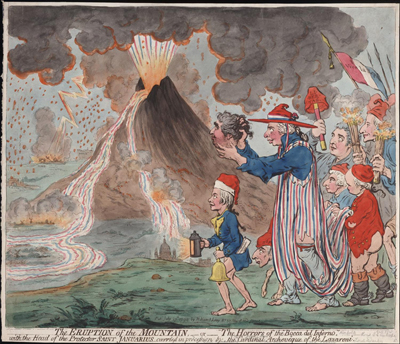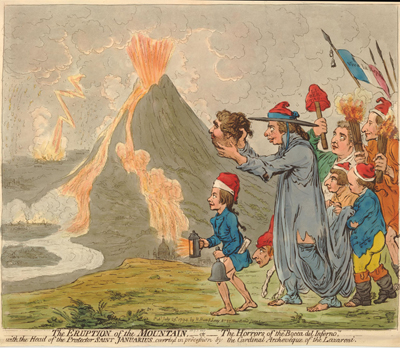The Eruption of the Mountain. . .
In mid-June, 1794, Mount Vesuvius suddenly erupted with a violence not seen since 1631. The news reached London by July and was reported in a number of papers including the St. James's Chronicle as follows:
On the [13th June 1794], at ten o'clock at night, all Naples was sensible of the shock of an earthquake, with an horizontal motion, which lasted about thirty seconds. On Sunday last, the 15th, about the same hour, the earthquake was repeated, which was followed by a violent eruption of Mount Vesuvius. The mountain opened, in two places, towards the centre of its line, when columns of black smoke, mixed with liquid inflamed matter issued from each mouth, and in a line towards the sea. . . . The lavas gushing from these mouths, after having run four miles in a few hours, destroyed the greatest part of the town of Torre del Greco, about a mile from Portici. . . .
It cannot yet be ascertained how many lives have been lost in that city. Many families are missing, but whether they have escaped, or are buried under the ruins of their houses is not known. Naples is covered with ashes, and every object is obscured as in a thick fog; but Vesuvius, though not visible, continues very turbulent, and more mischief may be expected. . . . The head of St. Januarius was carried in procession yesterday, and opposed to the mountain by the Cardinal Archbishop of Naples, attended by many thousands of the inhabitants of this city. [July 12, page 1.]
The patron Saint of Naples, Saint Januarius was a fourth century Catholic Bishop martyred during the reign of Diocletian by having his head cut off. One of the legends associated with him (almost certainly derived from an earlier pagan ritual) is that carrying his head in procession before Vesuvius would keep Naples safe from harm.*

© Lewis Walpole Library, Yale University
As he often did, Gillray used the images from this recent spectacular event as a visual metaphor to describe the present political situation. And it is certainly not difficult to see an analogy between the violent eruption of Versuvius (and the destruction it produced in surrounding territories) and the increasingly violent revolution in France (and its stated aim to spread its revolutionary principles across the rest of Europe).
This is clearest in versions of the print where the lava flow spewing from the mouth of Vesuvius—bocca del inferno (the mouth of Hell)—is painted in revolutionary tri-colour. Reflecting the recent French counter-offensive in the low countries, Gillray shows the revolutionary lava flow engulfing the two areas of Flanders and Holland with their windmills, and now threatening London symbolized by St. Paul's Cathedral and St. James's Palace.
Meanwhile a group of prominent Whigs forms a procession, a la Januarius, to stave off the threat of French attack. The procession includes (from left to right) Lauderdale (holding a bell and conspirator's lantern), Sheridan as Cardinal/Archbishop (in tri-colour drapery holding the head of the Whig Januarius, Charles James Fox), Grafton (portrayed as a dog beside Sheridan), Norfolk (with a bonnet rouge inscribed with "Libertas"), Stanhope (holding burning fasces, symbols of the combined power of the people), and Michaelangelo Taylor, and Earl Derby (holding Sheridan's train).

© Trustees of the British Museum
Unfortunately, Fox's solution to the French threat was to oppose the on-going war and to seek peace with France. As early as The Slough of Despond (January 3, 1793), Gillray had begun to depict Fox as a revolutionary himself associating him with French revolutionary symbols such as the tri-colour cockade, and bonnet rouge. Gillray continued that line of attack in the devastating A Democrat, or Reason & Philosophy (March 1, 1793) where he portrayed Fox as a bloody sans culotte. Then he included Stanhope in the attack with The Noble Sans-Culotte (May 3, 1794). But here in The Eruption of the Mountain he takes it one step further, illustrating the very process he is satirizing by expanding the number of revolutionaries to Lauderdale, Sheridan, Bedford, Taylor, and Derby marching as sans culottes with a tri-coloured flag inscribed with "Vive la Republique," while bonnets rouges are on full display.
* See also "An Account of the Eruption of Mount Vesuvius in a Letter from a Gentleman now at Naples, dated June 17" in The European Magazine and London Review, July 1, 1794.
Sources and Reading
- Commentary from the British Museum on TThe Eruption of the Mountain. . ..
- Draper Hill, Fashionable Contrasts, 1966, #9.
- "Januarius," Wikipedia
- "Mount Vesuvius," Wikipedia
- "Fasces," Wikipedia
- "Bell, book, and candle," Wikipedia
- "Symbolism in the French Revolution," Wikipedia
- "Flanders campaign," Wikipedia
- Thomas Wright and R.H. Evans, Historical and Descriptive Account of the Caricatures of James Gillray #114.
- Thomas Wright and Joseph Grego, The Works of James Gillray, the Caricaturist; With the History of His Life and Times, p. 177.
Comments & Corrections
NOTE: Comments and/or corrections are always appreciated. To make that easier, I have included a form below that you can use. I promise never to share any of the info provided without your express permission.